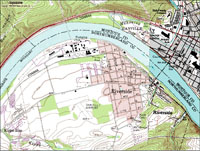History of Riverside

In 1790 a public road was laid out from Sunbury to what was then known as Gearhart's Ferry. In 1804, a turnpike was also constructed to Pottsville. The construction of these roads had brought business to the ferry and prosperity to the Gearhart family.
Up until the end of the Civil War, the Riverside area was sparsely populated with only a few families including he Carrs, the Boyds, the Depews and the Gearharts. Post war prosperity brought many would-be settlers into the area. With the prospect of a new major railroad on the south bank of the river had made the land even more desirable. A land association was formed in Danville to purchase 10 acres near the river bridge from the Harmon Gearhart Estate at a price of $10,000.00, but the Gearharts did not accept.
So, two years later in 1869, Thomas Beaver, Dan Morgan, I.H. Torrence and Benjamin G. Welch purchased a
hundred acres from the adjoining Dan Cameron farm. This land was located between the river and Sunbury Road, one half mile west of the bridge. The land was laid out in lots of 50 by 184 feet with wide avenues and streets between. O.H. Ostrander was appointed surveyor and real estate agent by the land association.
In less than two years, forty buildings had been constructed in the newly chartered Borough of Riverside. The great demand for real estate prompted the purchase of 30 adjoining acres from William Faux and 12 acres from Samuel Gulick in 1869.
In 1870, the Harmon Gearharts decided to lay out their own town named South Danville, Gearhart Township. The Gearhart lots were only 50 by 150 feet, resulting in unaligned streets between Riverside and South Danville. The boundary between the two communities is present day Line Street.
Another land association purchased acreage south of Sunbury Road form C.P. Gearhart and VanNostran farms in 1871. The lots of this land were laid out according to the Riverside plan.
A depression hit in 1873 resulting in the shutdown of the Danville iron mills and the unemployment of thousands. Many of the new homes in Riverside were foreclosed and sold in a Sheriff's sale at one-third their value.
After several years, the businesses of Danville, Riverside and South Danville revived and may of the people were able to buy back their homes. Construction began anew and by 1906 there were more than 1000 people and 160 buildings in Riverside and South Danville.
The two communities remained separate until 1950 when the newly arrived Merck and Company agreed to
treat the community sewage if they would install the mains. In order to take advantage of this offer, it became necessary for the two communities to merge. Petitions were approved by the court to combine Gearhart Township with Riverside.
Up until the end of the Civil War, the Riverside area was sparsely populated with only a few families including he Carrs, the Boyds, the Depews and the Gearharts. Post war prosperity brought many would-be settlers into the area. With the prospect of a new major railroad on the south bank of the river had made the land even more desirable. A land association was formed in Danville to purchase 10 acres near the river bridge from the Harmon Gearhart Estate at a price of $10,000.00, but the Gearharts did not accept.
So, two years later in 1869, Thomas Beaver, Dan Morgan, I.H. Torrence and Benjamin G. Welch purchased a
hundred acres from the adjoining Dan Cameron farm. This land was located between the river and Sunbury Road, one half mile west of the bridge. The land was laid out in lots of 50 by 184 feet with wide avenues and streets between. O.H. Ostrander was appointed surveyor and real estate agent by the land association.
In less than two years, forty buildings had been constructed in the newly chartered Borough of Riverside. The great demand for real estate prompted the purchase of 30 adjoining acres from William Faux and 12 acres from Samuel Gulick in 1869.
In 1870, the Harmon Gearharts decided to lay out their own town named South Danville, Gearhart Township. The Gearhart lots were only 50 by 150 feet, resulting in unaligned streets between Riverside and South Danville. The boundary between the two communities is present day Line Street.
Another land association purchased acreage south of Sunbury Road form C.P. Gearhart and VanNostran farms in 1871. The lots of this land were laid out according to the Riverside plan.
A depression hit in 1873 resulting in the shutdown of the Danville iron mills and the unemployment of thousands. Many of the new homes in Riverside were foreclosed and sold in a Sheriff's sale at one-third their value.
After several years, the businesses of Danville, Riverside and South Danville revived and may of the people were able to buy back their homes. Construction began anew and by 1906 there were more than 1000 people and 160 buildings in Riverside and South Danville.
The two communities remained separate until 1950 when the newly arrived Merck and Company agreed to
treat the community sewage if they would install the mains. In order to take advantage of this offer, it became necessary for the two communities to merge. Petitions were approved by the court to combine Gearhart Township with Riverside.
